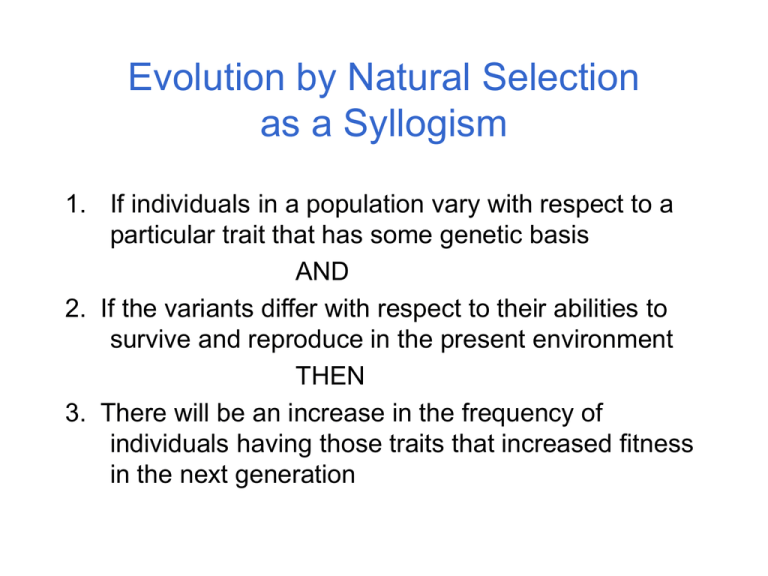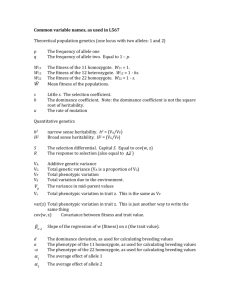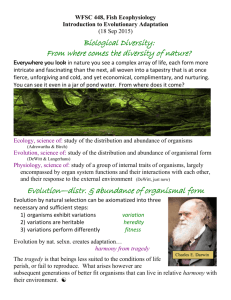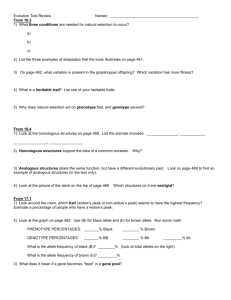Selection on Quantitative traits
advertisement

Evolution by Natural Selection as a Syllogism 1. If individuals in a population vary with respect to a particular trait that has some genetic basis AND 2. If the variants differ with respect to their abilities to survive and reproduce in the present environment THEN 3. There will be an increase in the frequency of individuals having those traits that increased fitness in the next generation The Syllogism Parallels the Breeder’s Equation R = h2S The breeder’s equation Parallel between the Syllogism and the Breeder’s Equation 1. If individuals in a population vary with respect to a particular trait that has some genetic basis AND 2. If the variants differ with respect to their abilities to survive and reproduce in the present environment THEN 3. There will be an increase in the frequency of individuals having those traits that increased fitness in the next generation h2 S R Evolutionary Response to Selection on a Quantitative Trait Offspring trait value Mean of offspring of selected parents Slope = 1.0 h2 = 1.0 R Population mean When h2 = 1, R=S S Mean before Mean after Parent trait value Evolutionary Response to Selection on a Quantitative Trait Offspring trait value Slope = 0.5 h2 = 0.5 Mean of offspring of selected parents Population mean R When h2 < 1, R<S S Mean before Mean after Parent trait value Selection Changes the Phenotypic Distribution of Quantitative Traits Across One Generation R1 _ z0 • The displacement of the mean of the character each generation is the response to selection • Given the same strength of selection, a larger heritability means a larger response. z1 • If heritability doesn’t change, constant selection yields constant response Evolutionary Response to Selection on a Quantitative Trait Across Multiple Generations R1 _ z0 R2 z1 R3 z2 • The displacement of the mean of the character each generation is the response to selection • Given the same strength of selection, a larger heritability means a larger response. z3 • If heritability doesn’t change, constant selection yields constant response Selection Changes the Phenotypic Distribution of a Population Response (R) = mean Zoffspring – mean Zparents Mean phenotypic trait in next generation R= h2S frequency Selection differential (S) = mean Zafter – mean Zbefore Mean phenotypic trait value BEFORE selection phenotype Mean phenotypic trait value of selected parents The Response to Selection also Depends on the type of Selection Selection as a Function • The response to selection depends on h2 and selection (R= h2S) • Selection is the relationship between an individual’s phenotype and its fitness Fitness Phenotype • Directional implies a continually increasing value of fitness as a function of the trait Effects of Directional Selection: Fitness Directional Selection Phenotype Directional Selection- Example • Remember Darwin’s Finches? Year 10.1 9.2 before survivors drought R= h2S Mean before drought= 9.2mm Mean of Survivors= 10.1mm Mean of next generation = 9.7mm • Extremes have the lowest fitness Fitness Stabilizing Selection Phenotype Stabilizing Selection- Example Optimum= 7lbs. 8oz • Karn and Penrose, 1951 • Data on >7000 male babies • Survival to 28 days • Extremes have the highest fitness Fitness Disruptive Selection Phenotype Disruptive Selection-Example • Fire-bellied seedcracker finch • 2 types of seeds available: large and small Dark bars show individuals that survived to adulthood Selection Surfaces • What about combinations of traits? • Adaptive Landscapes • Can view as topographic maps • Selection moves populations to nearest peak Example- Garter snakes • Brodie (1999) • Individuals with certain combination of traits (stripe + direct escape, unstriped + evasive escape) had higher survival than other combinations








